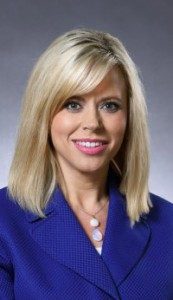Innovation Springing Up in Springdale
CompetencyWorks Blog

When you talk to Dr. Megan Witonski, Associate Superintendent in Springdale School District (AR), it feels like she is just about to jump out of the phone, she is that full of passion, insightfulness, and the all-important we-are-going-to-make-this-happen-ness. I couldn’t but help imagine her with a superhero cloak.
Springdale, based in Northwest Arkansas, has 23,000 students, half of whom are English Language Learners. The district is entering their second year of implementation of a new 8-12 School of Innovation. The strategy doesn’t end with a new school – Springdale is personalizing their school district by having six of their schools approved (and the waivers that come with it) under the Arkansas Department of Education School of Innovation initiative. These six schools all provide students to the School of Innovation, led by principal Joe Rollins.
We’ve all seen districts start up new innovative schools but leave the others to stagnate. Not so at Springdale. For example, they found that advisories have been instrumental in the new School for Innovation in lifting up student voice, ensuring strong relationships are built with students, and helping to personalize instruction and support so they can be confident students are learning. As a result, they’ve already introduced advisories into the other middle and high schools.
What Inspired Springdale to Personalize: Witonski explained that there were several forces at work leading them to personalization. First, they wanted to make sure they were fully preparing their students for life after high school. They wanted to reach beyond the basic requirements for graduation. Second, with half of their student body learning English and needing help to fully build up their strength in the academic use of English, they needed a model that would ensure every student was fully engaged and able to get the support he or she needed.
Witonski said, “We were doing a great job for most students, but there is a population we need to seek out new approaches to reach and help build a wider set of skills. We began by looking at the most important ingredients for what students needed to be ready for college and careers. We wanted to make sure they had all the tools in their toolbelt to be successful. From there, we looked at what a structure could look like that would help them build those skills.”
Let’s Create a School of Innovation: As described above, Springdale is doing a both/and strategy, creating a new secondary school while also transforming their current schools.

With the introduction by the Arkansas State Department of Education Schools of Innovation initiative in 2013, Springdale saw an opportunity. They wanted to move beyond seat-time requirements (they are very precise in AR, with credits based on specific minutes of instruction) so the emphasis would be on students learning the content, not sitting in the chair. They also wanted to open up the ways that students could learn to create more personalized learning opportunities. With their application approved for a new school, they opened up the School of Innovation (8-12) starting with 200 eighth graders in the 2014-15 school year and onboarding an additional 200 eighth graders this fall.
Witonski explained, “It was a stretch for everyone to begin to think in a personalized, competency-based model.” In fact, this year they’ve introduced an Innovation Boot Camp for parents so they know what to expect and how to support their students. (See Carri Schneider’s wonderful piece on learning how parents can support students in a competency-based environment.)
Springdale began to map curriculum starting a year and a half ago in ELA and math in an iterative process to identify what students need to know as compared to what it is nice to know. Teachers have the autonomy to build out courses that include the “need to knows,” with “nice to knows” as optional. This recognizes that if competency-based schools are going to be held accountable for student learning that includes higher order skills, it is important to narrow the expectations so students have both time to learn and opportunity to apply their skills. Witonski described this as “finding the happy medium” so teachers can have autonomy in designing curriculum and also accountability that students will definitely master the most important things (as compared to traditional schooling with its effort to cover curriculum regardless of how well students learn it).
At SOI, assessing progress is based on a four-part scale of emerging, developing, meeting (i.e., proficient), or exceeding. Their rubric for explanatory writing for grades 6-12 is one of the best I’ve seen in differentiating between what is proficient and what is exceeding proficiency. They obviously still have to calibrate the differences between the grade levels and the difference between proficiency and exceeding by looking at and discussing student work.
According to Rollins, in addition to competency-based education, other elements of the SOI design include:
- Students will be able to receive a high school diploma and Associate degree from Northwest Arkansas Community College.
- Blended learning with 1:1 devices
- Opportunity to have real-world experiences and receive a technical certificate
- Access to learning on demand
- The ability to experience an internship for student growth and development.
Arkansas was able to get a lot of the regulations out of the way for the schools in the Schools for Innovation initiative, but some still remain. For example, the Department of Education requires reporting to be based on age-based grades to provide a culminating transcript. So efforts to move toward standards-based report cards and broader bands upon which to structure progression will be planned for the future as policy changes and the high education realm accepts a competency based reporting system.
Partnerships: Most school districts can’t make the conversion to personalized, competency-based systems without the help of a few key partners. Witonski touted the Office of Innovative Education, led by Dr. Denise Airola, as a “wealth of knowledge and valuable sounding board” that has been able to scout down resources and information as they needed it. OIE is holding Arkansas’ first Education Innovation Summit on September 29.
The Center for Secondary School Redesign has been a valuable partner as well. Don Siviski, well-known as the superintendent who led the initial launch of proficiency-based learning at RSU2 and later took on state leadership in advancing proficiency-based learning across the state of Maine and now at CSSR, has been highly influential. Witonski explained that Siviski took the time to form relationships with district and school leaders, listening deeply to understand the context of Springdale and providing coaching along the way to principals in their role as change agents. Together they have been begun to identify the important things teachers need to know in order to manage personalized, competency-based classrooms. These partnerships provide students with the ability to access the competencies as they move through curriculum.
A Missing Piece – Student Voice and Choice: Witonski explained, “One of the things we realized we didn’t have enough of early on was student voice and choice.” In partnership with the Center for Secondary School Redesign, they created structures and practices that shifted the relationships between students, teachers, and parents. In addition to advisories, they also introduced student-led conferences. By law, Arkansas schools have to hold parent-teacher conferences shortly after the beginning of the school year. At the School of Innovation, they decided these would be student-led. Witonski explained that the “everyone was excited and nervous about what the process would look like and how students would lead the conversation. Students were equally nervous.” They found that in fact it was a powerful practice that shifted the responsibility of learning on to students, and was necessary for students, parents, and teachers to have deeper conversations about what needed to happen for students to make progress and excel.
Seeing how powerful they are in establishing student voice and shifting responsibility, they’ve taken student-led conferences district-wide from kindergarten through high school and advisories 6-12.
Designing for ELL Students: Springdale uses Understanding by Design as a starting point for designing curriculum. Given the size of their ELL population, they’ve already built up a strong division to support schools, including integrating literacy across the curriculum. Currently they are working with E.L. Achieve to build scaffolding and supports into the curriculum maps for ELL students as well as those with special needs. They are finding that one area they need to strengthen is around constructing meaning so prior knowledge of ELL students is more explicit (rather than assumed), and that there are scaffolds to help understand the vocabulary.
Advisory has also become an important place to ensure that ELL students are getting the supports they need, as some students excel in their studies while others need much more encouragement and more personalized support.
In Order to Shift from Pacing Guidelines to Ensuring Student Pace and Progress, an Information Management System is Necessary: One of the huge shifts in competency-based education is to support teachers in making sure students are on pace and making progress rather than focusing on curricular pacing guidelines. Springdale talked to many districts about the learning management systems they were using, but even so, their first vendor over-promised, thereby leaving them in the lurch.
This year they are using Schoology, which allows customizable menus for teachers, students, and parents. Witonski emphasized, “Parents need to have customizable options so they can get as much or as little information as they want. You don’t want to have a lack of information cause trepidation on the part of parents.”
There are still some challenges. Even though Schoology has a plug-in so information can be easily uploaded to the AR Department of Education, they haven’t worked through all the details yet, requiring teachers to do double-duty on data entry. As they continue to develop the School of Innovation, Springdale is also still discovering their own needs, so they are keeping an eye on new LMS products and developments.
– – –
There is obviously a lot more we can learn from Springdale. It’s a particularly interesting strategy to have a parallel strategies of design and conversion.
See also: